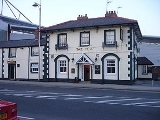
Turf Hotel
Encyclopedia
The Turf Hotel is a public house
in Wrexham
, North Wales
. The location of the pub on the corner of Wrexham AFC's Racecourse Ground
is what makes this pub famous not just in Wales but in the footballing supporters fraternity across the whole of the United Kingdom
.
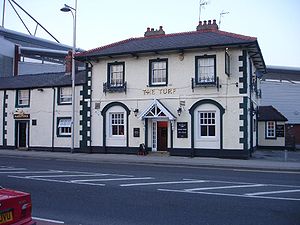
The most important fact about the Turf Hotel is that on 5 March 2007 it celebrated 130 years as being the oldest international football ground in the world. The first international on the Racecourse took place on that date in 1877 when Wales
lost 2-0 to Scotland
.
No other ground in the world has been an international venue as long as the Wrexham Racecourse, and yet another international is being held on the ground on 26 May, 2007. The first ever against New Zealand.
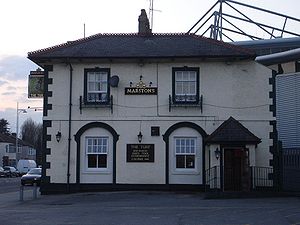 At one time the Turf was the subject of the quiz question; ‘Who is the only Football League Ground to have a pub on it?’ However, since the opening of the Pryce Griffiths stand in 1999, ensured that question is no longer relevant.
At one time the Turf was the subject of the quiz question; ‘Who is the only Football League Ground to have a pub on it?’ However, since the opening of the Pryce Griffiths stand in 1999, ensured that question is no longer relevant.
Situated on Mold Road, which is now regarded as the ‘Gateway into Wrexham’, the Turf has been situated in its present position long before the football club was actually founded.
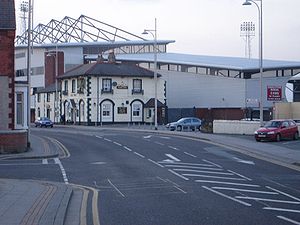 The first race meeting at the Racecourse was on 29 September 1807, and later a Grandstand was built next to the Turf, which later became known as the Mold Road stand when the football club was up and running.
The first race meeting at the Racecourse was on 29 September 1807, and later a Grandstand was built next to the Turf, which later became known as the Mold Road stand when the football club was up and running.
Known as the Turf Tavern, its name later changed to the Turf Hotel. This is believed to have happened when the original building was knocked down and replaced by the current building. Due to the lack of building records, there is no accurate date as to when the Turf Hotel replaced the Turf Tavern, but it is believed to have been rebuilt around the 1860s.
As well as horse racing, the Racecourse was also being used by this time by Wrexham Cricket Club, and it was from members of the Cricket Club that Wrexham Football Club was formed in 1872. Cricket Club members met at the Turf Hotel on 28 September 1872, for ‘the purpose of starting a football club for the ensuing season.’ This was to give them activities for the winter months.
Not long after, changing rooms were added next to the Turf for use by both cricketers and footballers. In fact the football pitch at this time lay from north to south, and so it remained until 1902, when it was changed to its present day situation of east to west.
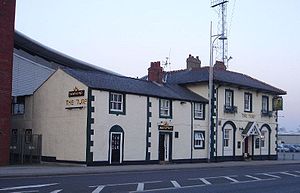 By this time the Turf had become a focal point for the local community for the many sporting events, and with the growth of football in North Wales
By this time the Turf had become a focal point for the local community for the many sporting events, and with the growth of football in North Wales
, the Racecourse became the home of Welsh football, with international games taking place there, as well as Welsh Cup finals.
The changing rooms were used right up until the late 1940s when new changing rooms were opened under the Plas Coch stand. The changing rooms adjacent to the Turf were situated upstairs, and the teams would climb down a wooden staircase and run out over planks onto the pitch. Also on the same floor were the club offices, which you could enter from Mold Road.
Sadly, part of the building adjoining the Turf, where the changing rooms and club office were situated, was demolished when the development of the Pryce Griffiths Stand took place.
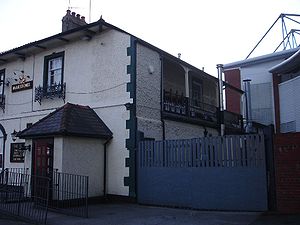 The balcony, which is still situated on the back of the Turf, was the prominent place for the local gentry
The balcony, which is still situated on the back of the Turf, was the prominent place for the local gentry
to watch the many sporting events taking place from there. There have been many other sporting events witnessed from the balcony, including cycling! In fact their once lay a cycling track around the pitch, whilst both boxing and wrestling has also taken place on the Racecourse.
In recent years the ground has played host for both Rugby League
and Rugby Union World Cup games, while up to the late 1960s the Turf itself had its own bowling green
situated where the pub car park is now.
Throughout all this time, the Turf has stood overlooking the Racecourse, witnessing many local and international sporting events. How this building is not already listed is beyond belief, yet you look into the town and see that the Seven Stars is a listed building; no disrespect to it, but a pub with far less history in the town of Wrexham, than the Turf Hotel.
Public house
A public house, informally known as a pub, is a drinking establishment fundamental to the culture of Britain, Ireland, Australia and New Zealand. There are approximately 53,500 public houses in the United Kingdom. This number has been declining every year, so that nearly half of the smaller...
in Wrexham
Wrexham
Wrexham is a town in Wales. It is the administrative centre of the wider Wrexham County Borough, and the largest town in North Wales, located in the east of the region. It is situated between the Welsh mountains and the lower Dee Valley close to the border with Cheshire, England...
, North Wales
North Wales
North Wales is the northernmost unofficial region of Wales. It is bordered to the south by the counties of Ceredigion and Powys in Mid Wales and to the east by the counties of Shropshire in the West Midlands and Cheshire in North West England...
. The location of the pub on the corner of Wrexham AFC's Racecourse Ground
Racecourse Ground
The Glyndŵr University Racecourse Stadium AKA The Racecourse Ground is a stadium located in Wrexham, North Wales. It is the home of Wrexham F.C. and, since 2010, the Crusaders Rugby League team who play in the engage Super League...
is what makes this pub famous not just in Wales but in the footballing supporters fraternity across the whole of the United Kingdom
United Kingdom
The United Kingdom of Great Britain and Northern IrelandIn the United Kingdom and Dependencies, other languages have been officially recognised as legitimate autochthonous languages under the European Charter for Regional or Minority Languages...
.

Introduction
Local historians are sure that most, if not every Wrexham fan reading this, who are over the age of 18, would have had at least one drink in the Turf Hotel over the years. For over a hundred years now, the Turf Hotel has become the meeting place on match days for some of Wrexham’s most inbred fans.The most important fact about the Turf Hotel is that on 5 March 2007 it celebrated 130 years as being the oldest international football ground in the world. The first international on the Racecourse took place on that date in 1877 when Wales
Wales national football team
The Wales national football team represents Wales in international football. It is controlled by the Football Association of Wales , the governing body for football in Wales, and the third oldest national football association in the world. The team have only qualified for a major international...
lost 2-0 to Scotland
Scotland national football team
The Scotland national football team represents Scotland in international football and is controlled by the Scottish Football Association. Scotland are the joint oldest national football team in the world, alongside England, whom they played in the world's first international football match in 1872...
.
No other ground in the world has been an international venue as long as the Wrexham Racecourse, and yet another international is being held on the ground on 26 May, 2007. The first ever against New Zealand.

Situated on Mold Road, which is now regarded as the ‘Gateway into Wrexham’, the Turf has been situated in its present position long before the football club was actually founded.
History
The local records are unclear, but it is believed that the ‘Turf Tavern’ was built between 1840 and 1844. It was first mentioned in the ‘North Wales Commercial’ (Business Directory) in 1844, and stated that the Landlord was a John Tench. The last North Wales Commercial before that was in 1840, and there was no mention of the Turf then.
Known as the Turf Tavern, its name later changed to the Turf Hotel. This is believed to have happened when the original building was knocked down and replaced by the current building. Due to the lack of building records, there is no accurate date as to when the Turf Hotel replaced the Turf Tavern, but it is believed to have been rebuilt around the 1860s.
As well as horse racing, the Racecourse was also being used by this time by Wrexham Cricket Club, and it was from members of the Cricket Club that Wrexham Football Club was formed in 1872. Cricket Club members met at the Turf Hotel on 28 September 1872, for ‘the purpose of starting a football club for the ensuing season.’ This was to give them activities for the winter months.
Not long after, changing rooms were added next to the Turf for use by both cricketers and footballers. In fact the football pitch at this time lay from north to south, and so it remained until 1902, when it was changed to its present day situation of east to west.

North Wales
North Wales is the northernmost unofficial region of Wales. It is bordered to the south by the counties of Ceredigion and Powys in Mid Wales and to the east by the counties of Shropshire in the West Midlands and Cheshire in North West England...
, the Racecourse became the home of Welsh football, with international games taking place there, as well as Welsh Cup finals.
The changing rooms were used right up until the late 1940s when new changing rooms were opened under the Plas Coch stand. The changing rooms adjacent to the Turf were situated upstairs, and the teams would climb down a wooden staircase and run out over planks onto the pitch. Also on the same floor were the club offices, which you could enter from Mold Road.
Sadly, part of the building adjoining the Turf, where the changing rooms and club office were situated, was demolished when the development of the Pryce Griffiths Stand took place.

Gentry
Gentry denotes "well-born and well-bred people" of high social class, especially in the past....
to watch the many sporting events taking place from there. There have been many other sporting events witnessed from the balcony, including cycling! In fact their once lay a cycling track around the pitch, whilst both boxing and wrestling has also taken place on the Racecourse.
In recent years the ground has played host for both Rugby League
Rugby league
Rugby league football, usually called rugby league, is a full contact sport played by two teams of thirteen players on a rectangular grass field. One of the two codes of rugby football, it originated in England in 1895 by a split from Rugby Football Union over paying players...
and Rugby Union World Cup games, while up to the late 1960s the Turf itself had its own bowling green
Bowling green
A bowling green is a finely-laid, close-mown and rolled stretch of lawn for playing the game of lawn bowls.Before 1830, when Edwin Beard Budding invented the lawnmower, lawns were often kept cropped by grazing sheep on them...
situated where the pub car park is now.
Throughout all this time, the Turf has stood overlooking the Racecourse, witnessing many local and international sporting events. How this building is not already listed is beyond belief, yet you look into the town and see that the Seven Stars is a listed building; no disrespect to it, but a pub with far less history in the town of Wrexham, than the Turf Hotel.

